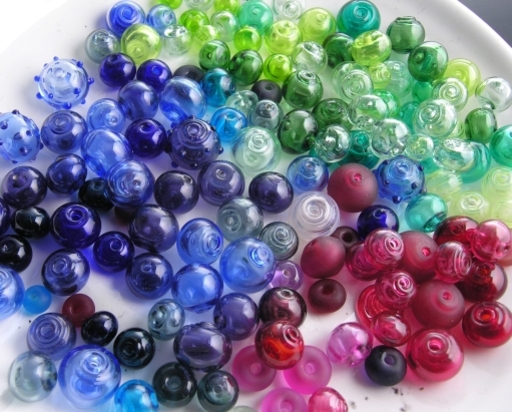I've always enjoyed making things very small; or at least since college, when my drawing instructors’ seemingly constant complaint was to draw bigger. My favorite tools were the .5mm pencil leads, the 4x0 technical pens, the c-100 nibs—and the nearly invisible dots I could make with them. When I embroidered, I divided the six strand floss into thirds, and indulged myself with french knots.
Hadn't it not been for the difficulties associated with obtaining suitable material, no doubt scrimshaw, perhaps set off with metalwork, would still be the focal points of my bead-strung jewelry. But circumstances intervened, and I took up glass beadmaking instead. It often seems to me that lampwork tends to hover around the one-inch (2.5cm) size, which I suppose makes sense—the torches put out flames typically half that in diameter, making much larger beads impractical, and beads that are too small hardly seem worth the money, when so many attractive “manufactured beads” come in the smaller sizes (say, up to 12–16mm).

purple and green minihollows, mixed with small solid spacers. January 2006, assorted soda-lime glasses. The distortion resulting from my camera's wide-angle capabilities is showing, here. The beads in both pix are resting on a saucer, of which the indent for the cup shows here, to give some sense of scale: the smallest hollows are roughly 6mm in diameter.
(Or I might simply have no idea what I'm talking about.) Be that as it may, once I got the basics down, I tended to make a lot of beads in the 20-25mm range; but many of my customers found smaller sizes more practical for their applications, and stock items have been edging down in size ever since. 10–13 has been the standard for some time now—easy to manufacture and use in many designs—but lately, I've been edging down even more, towards the 6mm range. To get them that small, it's easier to build ’em on a .045 or even .035” mandrel, but there's a tradeoff, because holes that small makes cleaning the magnetic pins out of them a pain. Morevoer, mandrels that thin are very prone to bending.
I haven't really tried to sell these yet. Why would anyone pay $9 or more for a 6mm hollow bead when they can purchase a gorgeous—even one of the fancy shaped ones, let alone a series 5000 (faceted round) or the typical 5301 (bicone) swaroski crystal for a fraction of the cost?
But they're certainly fun to make, and awfully cute.
file created 08aug06
Unless otherwise noted, text, image and objects depicted therein copyright 1996--present sylvus tarn.
Sylvus Tarn